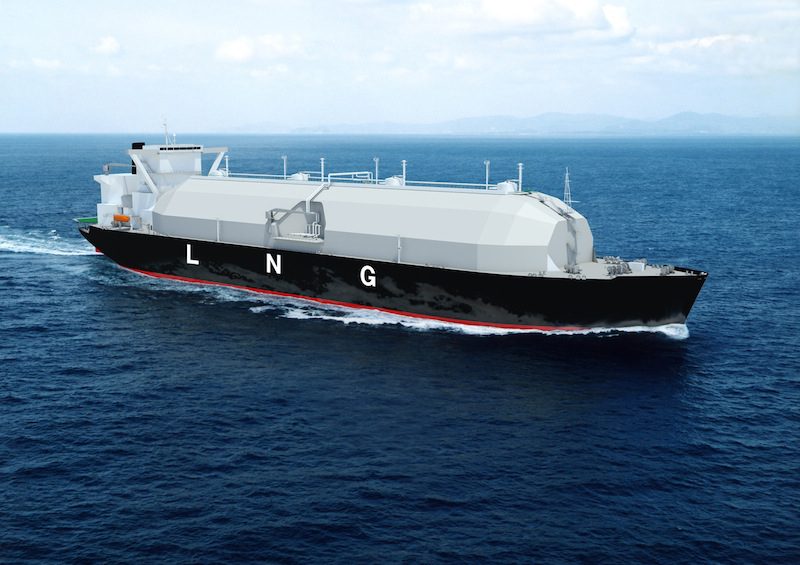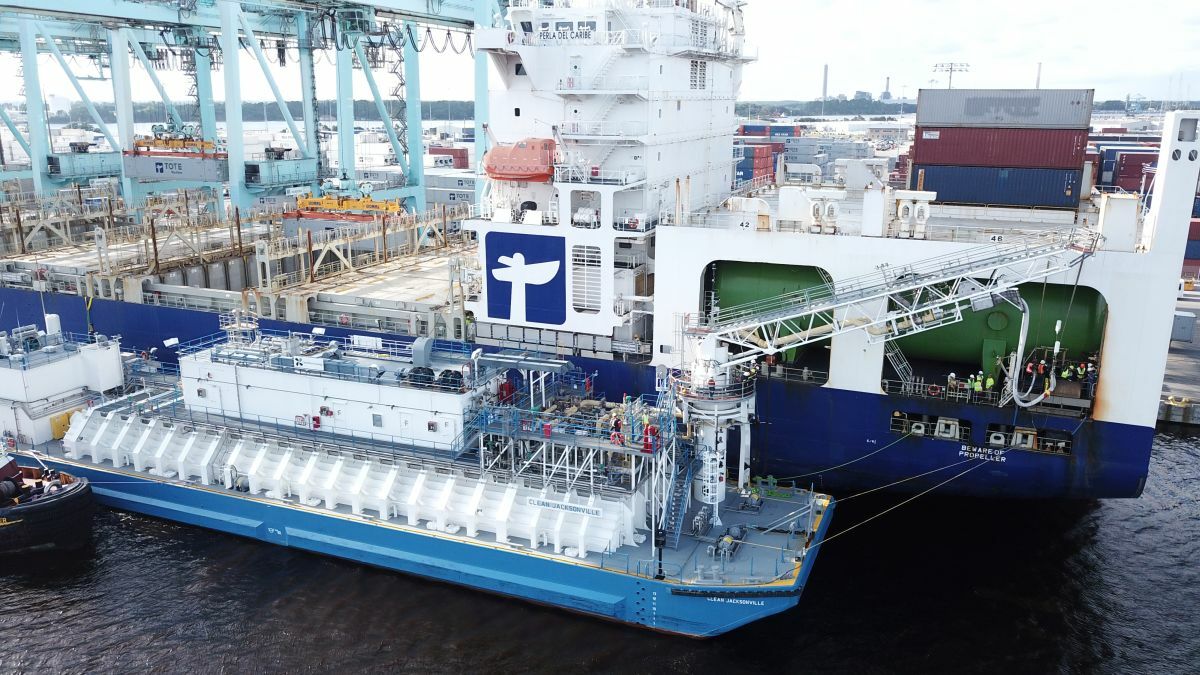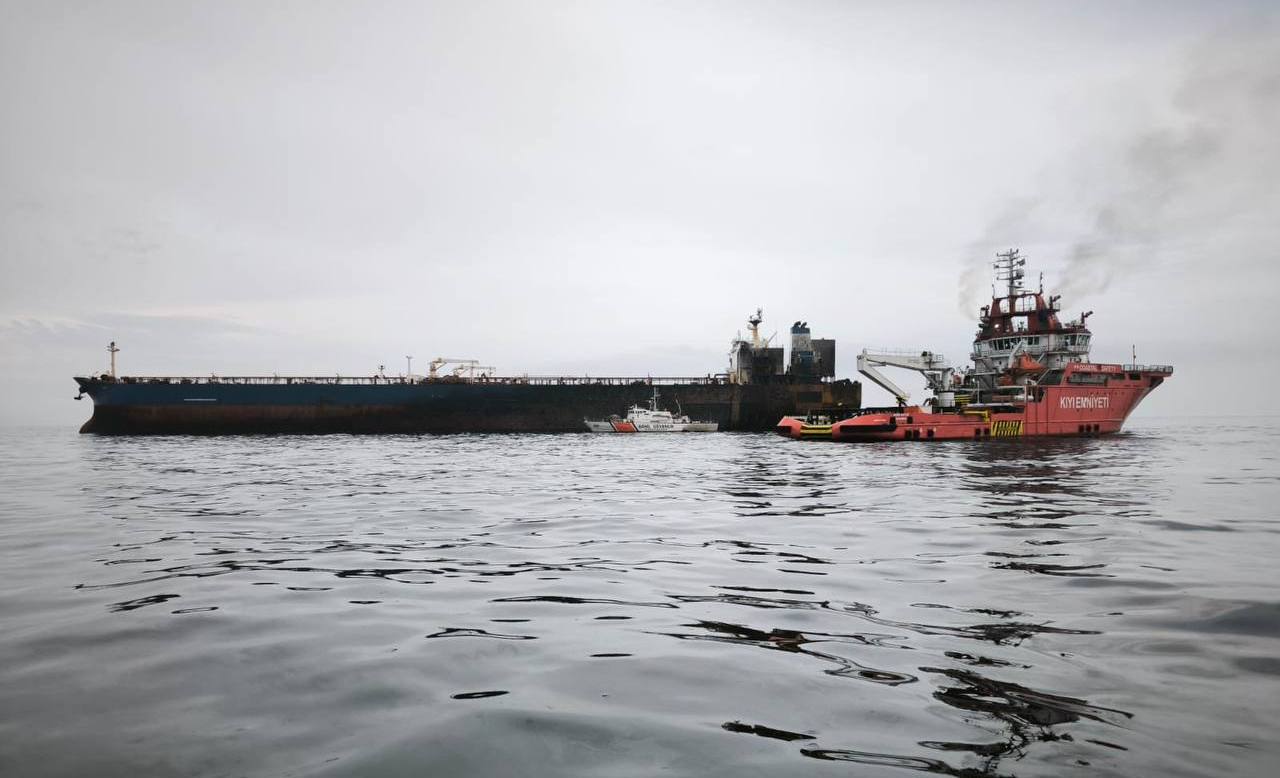A MHI-designed “Sayaendo” LNG carrier, featuring a peapod-shaped continuous cover over Moss spherical tanks. Illustration courtesy MHI
By Masumi Suga, James Paton and Kyunghee Park
(Bloomberg) — At a shipyard in southern Japan, Mitsubishi Heavy Industries Ltd. engineers envision the newest fuel- efficient engines for liquefied natural gas carriers while others design tanks with greater capacity.
Years after South Korean rivals became the world’s largest shipbuilders, the Japanese stand at the cusp of clawing back some of the industry they once dominated.
LNG is the catalyst. With several projects around the globe set to begin shipping in the next few years and Japan already the largest importer of the super-cooled fuel, Japan shipbuilders are anticipating a windfall. And while lower oil prices are threatening the viability of some LNG projects, some remain convinced the industry’s growing pains are mere road bumps in a longer game and that their advances in technology provide an edge.
“The wind is in the sails of Japan’s shipbuilders,” said Nobutaka Nambu, chief executive officer at World Ships Future, a consultant for the shipbuilding and shipping industries in Tokyo. “They are now placed to take a step forward. They are now in a position to make a dent in the Koreans’ oligopoly.”
LNG trade is set to exceed $120 billion this year, overtaking iron ore to become the most valuable physical commodity after oil, analysts from Goldman Sachs Group Inc., including Jeffrey Currie, said in an e-mailed report recently.
All that trade means more ships to move the fuel.
LNG is formed by squeezing and cooling natural gas until it becomes a liquid, making it suitable to be shipped over long distances in specially built ships with insulated tanks.
The carriers typically sell for as much as $200 million apiece and the largest can measure about 345 meters (1,130 feet) in length, or almost four American football fields.
LNG Focus
Japan entered the LNG tanker market in 1981, more than a decade after it first imported the cleaner energy from Alaska. By tapping power demand in the resource-scarce nation, domestic yards expanded and led the global fleet of gas carriers in the 1980s and the early 1990s. South Korean shipbuilders later emerged, ending Japan’s reign in 2000 when their carrier deliveries exceeded those of the Japanese for the first time.
Four years after the Fukushima nuclear meltdown spurred the closure of Japan’s many reactors, LNG is seen as one of the best ways to meet the country’s energy needs. LNG imports rose to a record 88.5 million metric tons in 2014, the finance ministry said in January.
A total of 50 to 60 LNG ships annually are forecast to be delivered globally in 2017 and 2018, aided by U.S. shale export projects, according to an estimate by analyst Masanori Wakae at Mizuho Securities Co. Of the total, 12 to 15 ships may be delivered by Japanese suppliers, with the remainder likely to be supplied by the South Koreans. Japan yards delivered seven vessels in 2008 and just two ships in 2013, according to Wakae.
New Technology
The efforts to regain lost market share in the tanker market are on display in the next generation of LNG tankers currently in the works at shipyards throughout Japan.
Japanese shipbuilders, including Mitsubishi, mostly use a type of design that stores LNG in spherical tanks. LNG carriers manufactured in South Korea typically have flat decks with containment tanks fitted into the hull.
Mitsubishi Heavy, Japan’s top producer of LNG vessels, has designed an LNG ship outfitted with a propulsion system powered by steam turbines and engines that can be fired by gas for efficiency. The carrier has also adopted a new design for the tanks that carry the LNG. The apple-shaped tanks will be able to carry 16 percent more gas than conventional designs, the company says.
Japan Marine United Corp. and partner IHI Corp. will resume construction of large-size gas carriers after a two-decade lull. The group is trying to lure customers with LNG vessels using a proprietary tank design technology called SPB, which uses prismatic-shaped aluminum tanks stored under a ship’s deck.
Storage Tank Design
The design results in a Korean-styled flat upper deck, which reduces wind resistance and makes the group’s LNG ships more fuel-efficient, Shinjiro Mishima, president of shipbuilder Japan Marine, said in an interview. The tank system is also designed to eliminate sloshing, providing an edge over Korean- built ships, Mishima said.
“The best feature of the SPB is the flexibility of the shape of the tank, which enables us to pursue improvement of the most important propulsion performance,” Mishima said. “Since it’s our own technology, we are able to develop the ship in any way we want.”
About 90 million metric tons of new LNG projects will need to be approved over the next five years to meet long-term demand, Sanford C. Bernstein estimated in a recent report. Global demand is forecast to rise about 80 percent to about 440 million metric tons per year by 2025, according to Bernstein.
Domestic Orders
South Korean shipbuilders aren’t sitting still. Daewoo Shipbuilding & Marine Engineering Co., which by itself secured half of all new LNG carrier orders last year, is focusing on trying to win orders by offering a new technology designed to help minimize LNG loss during transport.
Daewoo Shipbuilding said in February that it will build an LNG carrier for Mitsui O.S.K. Lines Ltd., Japan’s second-biggest publicly traded ship owner. In total, Daewoo has won six LNG ship orders so far this year.
Japan’s domestic shipping customers Nippon Yusen K.K. and Mitsui O.S.K. are the world’s largest operators of LNG carriers. The nation’s top three shippers will likely together spend more than 1 trillion yen ($8.3 billion) by 2020 to expand their LNG fleet to at least 281, including vessels jointly owned by other companies, according to plans unveiled by the companies.
Energy Needs
About 70 percent of commercial ship orders received at Japanese yards come from domestic shipowners, according to data compiled by the Japan Ship Exporters’ Association.
“Domestic shipbuilders are less vulnerable to the oil prices because their shipping customers have long-term contracts with cargo owners,” said World Ships Future’s Nambu. “Gas is cleaner energy and the longer-term view regarding Japan’s importing of LNG won’t change.”
Japan has agreed with the U.S. to buy about 20 percent of its need of the fuel from shale projects. It plans to buy about 17 million tons a year to be shipped from terminals in Louisiana, Maryland and Texas, according to a document compiled by the nation’s trade ministry.
“Given that LNG is forecast to trade in such big volumes, demand for ships should be quite big,” said Shigeyasu Tanaka, general manager of Mitsubishi Heavy’s ship and ocean business. “In a sense, demand for LNG ships will continue.”
Shipping Rates
But even with the long-term outlook calling for the LNG market to continue to grow, risks remain. Sagging crude prices pressure LNG since the gas is pegged to oil. Moreover, shipping rates have been falling because of weak global demand for LNG at the moment.
Gas prices, which have fallen along with oil, have made some global LNG projects unprofitable and threaten to damp the speed of investment in facilities and ships, JMU’s Mishima said.
“The LNG industry is suffering from an anxiety attack over falling oil prices and uncertainty around global growth,” analysts at Bernstein wrote. “This will lead to stalled new investment in 2015, although we believe this will be temporary.”
Copyright 2015 Bloomberg.

 Join The Club
Join The Club











